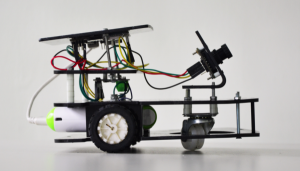4Duino Intelligent Buggy project demonstrate how does uCAM-II works. This project also utilized two 4duino communicating using Server-Client architecture over TCP. It also uses a buggy car which carry the 4duino server and uCAM-II. By using built-in ESP8266, 4duino client sends a request to 4duino server to move the buggy and capture photo via wireless communication.
Server-Client architecture is a network architecture which separates devices and application programs into two categories clients and servers to better employ available computing resources and share data processing loads. Initially, client uses the network as a way to connect and then sends a request. The server will take the request and makes sure that the request is valid. If valid it fetches the request and serves the client.
In this project, TCP is used. Transmission Control Protocol or TCP is responsible for providing a reliable communications between hosts and processors on different hosts, it manages message acknowledgment and retransmissions in case of lost parts. Thus there is absolutely no missing data. In TCP, data can be sent bidirectional.
uCAM-II is an integrated serial camera module. This is attached to the server 4duino as its host to enable image capturing feature of this project. This module uses a CMOS VGA colour sensor along with JPEG compression chip. This camera uses a simple serial protocol. Please refer to uCAM-II Demo which shows how to interface 4duino to uCAM-II and capture jpeg images then store it in the uSD card.
How it works
Components
- 4duino (2 items)
- uCAM-II
- Buggy Robot
- Jumper cables
- 5V power supply
- micro USB cable
Implementations
Step1: Build
Connect uCAM-II to 4duino server using Software Serial Pin (10,11).
Also, connect the buggy robot to 4duino server using Pins 4, 5, 6 and 7 as illustrated below.
Step2: Program
Workshop 4 – 4Duino Extended Graphics environment is used to program this project.
This project requires the Arduino IDE to be installed as Workshop calls the Arduino IDE for compiling the Arduino sketches. The Arduino IDE however is not required to be opened or modified to program the 4Duino.
Program 1 (Client):
Program 2 (Server):
Open the above files using Workshop 4.
Simply change the SSID and the PASSWORD to suit your router, on both the program.
Note: You can download the code here.
Step3: Upload (Client)
Connect the first 4Duino (Client) to the PC using uUSB cable (similar to Arduino).
Then navigate to the Comms tab and select the Comms port to which the Client 4Duino connected.
Now click on the “Comp’nLoad” button on Program1 (Client).
The Workshop 4 IDE will prompt you to insert a µSD card to the PC in order to save the widget images. Since we do not used widgets or any special objects for the server, click “No Thanks”.
The image above should appear in the 4duino Client display.
Step 4: Upload (Server)
Similarly, connect the second 4Duino (Server) to the PC using uUSB cable (similar to Arduino).
Then navigate to the Comms tab and select the Comms port to which the Client 4Duino connected.
Now click on the “Comp’nLoad” button Program2 (Server).
Workshop 4 IDE will prompt you to insert a µSD card to the PC in order to save the widget images. Click “OK”.
This image must be displayed on the 4duino Client’s LCD.
Step 5: Connecting Power Supply
Apply a portable 5V power supply to the 4duino used as Server. Use the micro usb cable to connect it to 4duino.
Read more: Intelligent Buggy featuring 4Duino-24

